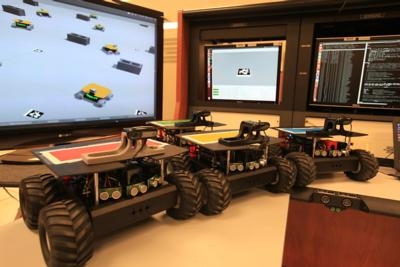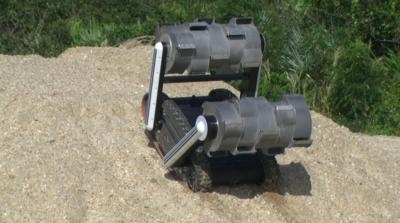Autonomous Machines Could One Day Explore Alien Worlds
A small band of NASA engineers and interns is about to begin testing a group of robots and related software that will show whether it's possible for autonomous machines to scurry about an alien world such as the moon searching for and gathering resources just as an ant colony does.

Building on the research conducted at the University of New Mexico, the engineers at NASA's Kennedy Space Center in Florida have been developing programs that tell small, wheeled robots to go out in different directions and randomly search an area for a particular material.
For these tests that are meant only to prove the software works and the concept is worthwhile, the robots are not searching for anything more than barcoded pieces of paper. In the future though, robots working around an asteroid or on the moon or Mars would be equipped to scan the soil for infinitely valuable water-ice or other resources that can be turned into rocket fuel or breathable air for astronauts.
For now, the testing is limited to parking lots around Kennedy's Launch Control Center using four homemade robots called "swarmies" that resemble stripped-down radio-controlled trucks. There are four of them, each with a webcam, WiFi antenna and GPS device. They are being programmed to work on their own to survey an area, then call the others over when they find a cache of something valuable. It's identical to the way an ant colony gathers around a food source to divide up the task of collecting the food and taking it back to the nest.
"We’re entering the phase where we do a ton of trial runs and collect the data and that’s well ahead of schedule," said Cheryle Mako, an engineer at Kennedy who is leading the project. "From an investigation perspective, we are spot-on and have made great strides."
Kurt Leucht, a Kennedy engineer working on the project, considers it possible that future missions could use this concept in a scaled-up manner to handle any number of robots a mission wants to send into space.
"Assuming this pays off, we know somebody’s going to take this and extend it and go beyond the four or five rovers we have here," Leucht said. "So as we design this and work it through, we’re mindful about things like minimizing bandwidth. I’m sure there will be a team whether it’s us or somebody else who will take this and advance it and scale it up."
The engineers also use a computer simulator that wrings out their software before they turn on a single swarmie at all. The simulator allows them to test the network with many more robots at the same time without having to build a huge fleet of them.

As the testing proceeds through the coming months, the team plans to include the RASSOR, an experimental mining robot designed at Kennedy to try out different techniques for digging into the lunar or Martian surfaces to gather useful materials.
Compared to scientific robots such as the car-sized Curiosity rover operating on Mars now, the swarmies and RASSOR are much smaller and built with only a couple of instruments and a single purpose.
"For a while people were interested in putting as much smarts and capability as they could on their one robot," Leucht said. "Now people are realizing you can have much smaller, much simpler robots that can work together and achieve a task. One of them can roll over and die and it’s not the end of the mission because the others can still accomplish the task."
Mako also offered some suggestions for using a swarming robots system on Earth. Assuming testing in the fall goes alright, the system can likely be called and modified for use in search and rescue tasks, with small robots heading out looking through the wreckage of a natural disaster or crash. They also could make efficient inspectors of pipelines and water mains, she suggested.
"This would give you something smaller and cheaper that could always be running up and down the length of the pipeline so you would always know the health of your pipelines," Mako said. "If we had small swarming robots that had a couple sensors and knew what they were looking for, you could send them out to a leak site and find which area was at greatest risk."
(Images provided by NASA. Top:The four "Swarmies" robots on a table with the software simulation used to develop the program to control the robots. Bottom: The prototype mining robot called RASSOR will be incorporated into the "swarmie" tests to see how well the software translates to different robotic vehicles. RASSOR is a concept robotic vehicle evaluating designs for a future craft that could work on another world.)
 ANN's Daily Aero-Linx (04.15.24)
ANN's Daily Aero-Linx (04.15.24) Classic Aero-TV: 'No Other Options' -- The Israeli Air Force's Danny Shapira
Classic Aero-TV: 'No Other Options' -- The Israeli Air Force's Danny Shapira Aero-News: Quote of the Day (04.15.24)
Aero-News: Quote of the Day (04.15.24) Airborne 04.16.24: RV Update, Affordable Flying Expo, Diamond Lil
Airborne 04.16.24: RV Update, Affordable Flying Expo, Diamond Lil ANN's Daily Aero-Term (04.16.24): Chart Supplement US
ANN's Daily Aero-Term (04.16.24): Chart Supplement US




